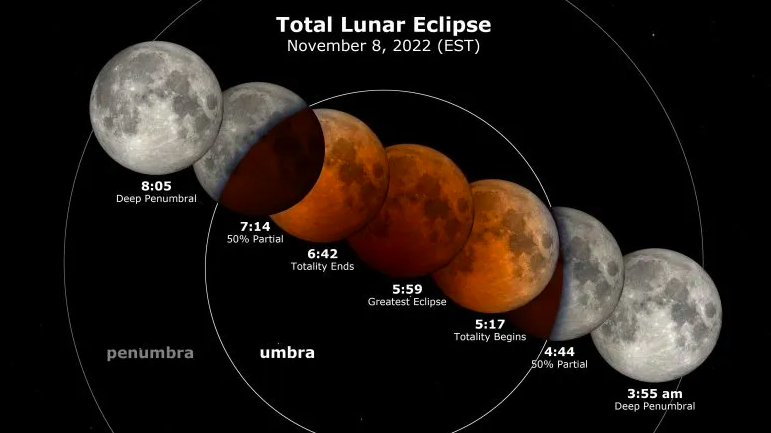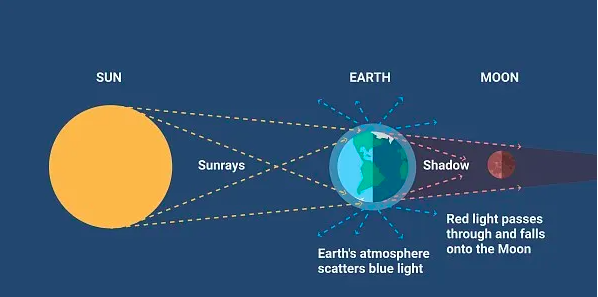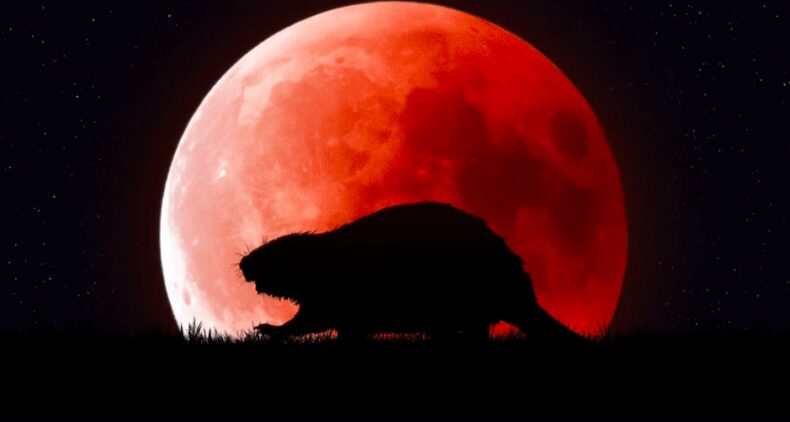A Beaver Moon, or the first full Moon of November, occurs on November 8, 2022, it is known as a Lunar Eclipse since it is the last Lunar Eclipse until 2025.

The Pacific, Asia, Australia, New Zealand, and America will all be able to see this eclipse (Central and North). The moon will rise in the evening in Asia and Australia, and individuals in America will be able to see it in the early morning before the moon sets. We can see it with our naked eyes. The proximity of Uranus to the eclipsed moon, which will be seen briefly before disappearing below the moon, is another intriguing event.
The lunar eclipse: what is it?
While the Moon orbits Earth and Earth revolves around the Sun, a situation arises in which Earth moves into the path of the Sun and Moon, blocking the sunlight that would otherwise be reflected off of both the moon and the Sun. As a result, the moon is left in the shadow of Earth. The “Lunar Eclipse” is the name given to this occurrence.

The Lunar Eclipse is of three types-
- Total Lunar Eclipse
- Partial Lunar Eclipse
- Penumbral Lunar Eclipse

The total lunar eclipse occurs when the Earth passes directly between the Sun and the Moon, meaning that the Sun and the Moon are on opposing sides of the planet and all three are lined up. The Earth’s atmosphere removes the blue light from the Moon and Sunlight, making the Moon appear red. The Earth’s slanted orbit prevents it from happening all the time, thus the moon usually passes above or below the Earth.
When Earth is positioned so that only a portion of the Moon’s surface falls within the Earth’s shadow, a partial lunar eclipse takes place. In this, the Moon’s surface appears to be unusually black due to the Earth’s shadow.
The Penumbral Lunar Eclipse happens when the Sun, Moon, and Earth are not exactly aligned. As a result, the Earth prevents the Moon from receiving direct sunlight and partially or completely covers it with its shadow. The Penumbra is this. The shadow of Earth’s penumbra is considerably lighter than its dark centre (Umbra). Therefore, it might be challenging to distinguish between a Penumbral Eclipse and a Regular Full Moon.
How long will the lunar eclipse last?
The duration of today’s eclipse will be roughly six hours since it will first enter the Penumbra, which is Earth’s outside shadow, then enter the Umbra, which is Earth’s inner shadow, and finally exit the outer side. Even so, there are two factors—near totality and the moon’s orbital speed—that can affect how long an eclipse lasts.
Because their orbits are eccentric and not perfectly round, the Moon and the Earth. This causes the moon to occasionally be closer to Earth and occasionally farther away. The Moon’s orbital speed changes as a result of this shift in the distance. In other words, the Moon moves faster when it is closer to the Earth’s surface and slower when it is farther away.
Another factor is that, unlike in a partial lunar eclipse, the moon remains in the umbra of the Earth during a total lunar eclipse.
Why is it called a Beaver Moon?
The only light the moon received because of the Sun’s obstruction was that filtered through Earth’s atmosphere, which caused the colour of the moon to darken and gave the impression that it was a copper vessel. It is called the “Blood Moon” for this reason. Although the level of redness might change depending on the weather, including pollution, dust storms, smoke, etc.
The Beaver Moon: What is it?
The Beaver Moon and the Lunar Eclipse of November 8 are conjunct. The first Full Moon of November is referred to as “A Beaver Moon.” This word, which Almanac adopted, refers to the Algonquian languages that Native Americans, colonial Americans, and Europeans all spoke. Each Full Moon designation covered not only the Full Moon but also the full Lunar Month in which it happened as well as all of the Moon’s phases.
The Beaver is chosen as the symbol for the full moon in November because in North America at this time of year, beavers find refuge and store up food while being hunted for their thick furs.
This lunar eclipse is known as “A Beaver Moon” because it coincided with the phenomena of the total lunar eclipse and the beaver moon.
Read More: https://tdznkwjt9mxt6p1p8657.cleaver.live/the-oldest-planetary-debris-in-galaxy-discovered/













